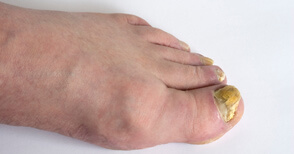What Is A Fungal Nail Infection?
 Fungal infections are the most common skin conditions of the feet. One in five people are likely to be affected during their life, and they are a common cause of thick, deformed and discoloured nails. The appearance of fungal nails can be quite unsightly and be a source of embarrassment and even cause some to lose their confidence so that they avoid certain activities such as swimming or other sports involving communal changing areas. The nails change from a healthy pink colour to a yellow/green colour, it is often thick and flaky in appearance and may become detached from the nail bed. The onset of infection is gradual, but after, the progression is relentless and therefore requires intervention to get rid of them.
Fungal infections are the most common skin conditions of the feet. One in five people are likely to be affected during their life, and they are a common cause of thick, deformed and discoloured nails. The appearance of fungal nails can be quite unsightly and be a source of embarrassment and even cause some to lose their confidence so that they avoid certain activities such as swimming or other sports involving communal changing areas. The nails change from a healthy pink colour to a yellow/green colour, it is often thick and flaky in appearance and may become detached from the nail bed. The onset of infection is gradual, but after, the progression is relentless and therefore requires intervention to get rid of them.
 The infection can even affect the underlying nail bed (the fleshy part of the toe which the nail sits on) and it will often spread to more than one nail. The big and little toenails are the most commonly affected. If nothing is done to treat an infected toenail, the condition may become progressively worse until the nail is so thick that it’s painful to wear shoes and in extreme cases, the nail bed itself may be completely destroyed, so that it is no longer possible for a new nail to form.
The infection can even affect the underlying nail bed (the fleshy part of the toe which the nail sits on) and it will often spread to more than one nail. The big and little toenails are the most commonly affected. If nothing is done to treat an infected toenail, the condition may become progressively worse until the nail is so thick that it’s painful to wear shoes and in extreme cases, the nail bed itself may be completely destroyed, so that it is no longer possible for a new nail to form.
What Causes Fungal Nail Infections?
Fungi are plant-like organisms that are parasitic, which means that they live off the tissue of other organisms, and because they thrive in warm, dark and moist environments, they find feet (especially feet in socks and shoes) an extremely attractive environment. There are different types of fungi, and the ones primarily responsible for nail infections are called dermatophytes. In fact, most nail infections develop as a result of athlete’s foot (technically known as Tinea Pedis), a dermatophyte infection of the skin of the feet, especially between the toes.
The fungi live in a protein called keratin, which is part of the outer layer of skin, and can easily spread to the nail where it causes a nail infection. They are caught in damp communal areas such as swimming pools, changing rooms and communal showers. It’s wise, in such areas, to take precautions such as never walking barefoot and never sharing towels, socks or shoes. Other risk factors can increase your chances of developing a fungal nail infection. Drugs or illnesses that weaken the immune system, e.g. AIDS, can lead to a fungal nail infection as can diabetes, psoriasis and smoking.
How To Treat Fungal Nail Infections
The two most widely used topical medications are amorolfine and tioconasole, the former being generally considered as the more effective. Usually, topical treatments work better on thinner nails, and creams are available to achieve this. These creams (containing 40% urea) should be applied nightly until the nail is significantly thinner or removed altogether.* A quicker alternative to cream is to visit a foot clinic, where a surgical drill can be used to thin the nail right down.
There are two principal drugs used in oral treatment – terbinafine and itraconazole. Both work by breaking down the fungal cell structure and, ultimately, killing the fungal cells.
These can be broadly divided into two main categories – those that produce heat and those that do not. The former destroy the fungi by vaporising them, while the ‘cold’ lasers work by enhancing the body’s immune response. Some impressive results have been seen, though not much is known about the long-term cure rate of laser therapy.
This is an option in extreme cases, though patients are still at risk of re-infection unless great care is taken post-surgery.
Other medications have recently been announced, such as tavaborole and efinaconazole (both topical), though they are not as yet widely available. The former works by inhibiting the action of an essential enzyme which leads, ultimately, to the death of the fungal cells. Tea tree oil (an antiseptic with antibacterial and antifungal properties) is another option, though the exact mechanism of action is not known.
Before & After Images

Fungal Nail Infection*

Fungal Nail Infection*
Prevention – Much Better Than Cure
There’s no 100% guaranteed way of avoiding fungal nail infections (if you’re going to live a normal life), and even those who are highly disciplined about hygiene can still acquire an infection. Nevertheless, those who have poor hygiene are at much greater risk of becoming infected. To minimise this risk, the following basic steps should be followed:
- Thoroughly wash the feet daily with warm soapy water, not forgetting between the toes.
- Make sure your feet are completely dry before putting on socks.
- Wear socks and footwear that help your feet breathe – these are generally made from natural fibres such as leather and cotton.
- Consider throwing away old and worn out footwear which may be harbouring the infection
- Avoid going barefoot in public places, particularly damp communal areas such as swimming pools, changing rooms and showers.
- Wear flip flops in places where others go barefoot.
- Promptly treat any case of athlete’s foot with antifungal sprays and powders (ideally, you should treat feet and footwear).
- Keep nails short.
- If you do have a fungal nail infection use a separate nail clipper for clipping the infected nail
- Avoid nail trauma which can predispose the nail to infection.
- Avoid sharing towels, shoes and socks.
- If you suffer from excessive sweating (hyperhidrosis), you should address the problem. Treatments fall into three main categories: medication, electrotherapy and surgery. These can have side effects, so it’s important to have them clearly explained to you before starting any course of treatment.
* Appearance after one treatment, several sessions are required to completely eliminate the infection.
